Built to Last
The seventh-generation owners of H.N. Williams carry on the legacy of their family business through a series of thoughtful and timely renovation projects
STORY BY BENJAMIN LERNER
PHOTOGRAPHY BY JIMMY iENNER, JR.
HISTORIC PHOTOS COURTESY H.N. WILLIAMS
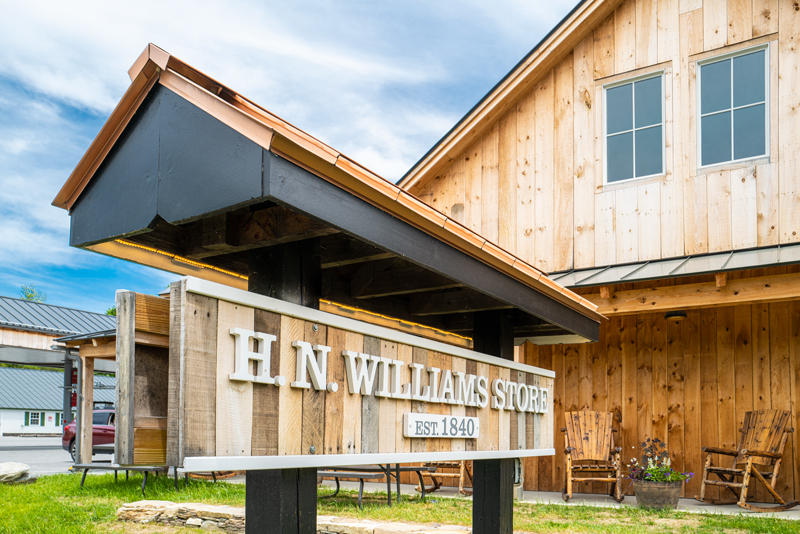
It’s been nearly two centuries since H.N. Williams first opened its doors in 1840, but the store still holds a special place in the hearts of both lifelong locals and visiting tourists. Inside, the walls are bedecked with antique winter sports equipment and historic photographs. Wooden floors and timeworn agricultural machinery lend an air of rustic nostalgia to the store’s numerous rooms, which are stocked with name-brand outdoor apparel, Vermont-made food items, farm supplies, Vermont craft beer, kids’ toys, and hundreds of other high-quality products. Each room tells a different part of the story of the Williams family, and every generation of the Williams family has made its own distinctive mark on the business.
Over the past two decades, H.N. Williams’ current owners, Billy Brownlee and Gerritt Brownlee, have embarked on a series of ambitious renovation and construction campaigns. Their hard work has paid off in the form of several beautiful new spaces and additional amenities, including a newly-built addition at the northern end of the building with soaring ceilings, a recently-excavated basement section, and several gas pumps, which stand underneath a tall fuel canopy that is covered with wooden siding. The recent additions have ensured the continued prosperity and relevance of their beloved family business, bringing new levels of beauty to the structure in a manner that still honors its historic roots.
Family History and Generational Growth
The story of H.N. Williams begins in 1840, when William Williams moved his tannery and harness shop to a small clearing that would later become Route 30. A lifelong Vermonter, Williams was born into a family that had already made a significant impact on the history of the Green Mountain State. Williams’ mother, Abigail Kent, was the granddaughter of Cephas Kent, who operated the Cephas Kent Inn in Dorset during the 18th century. It was there that the “Dorset Conventions” were held in 1775 and 1776.
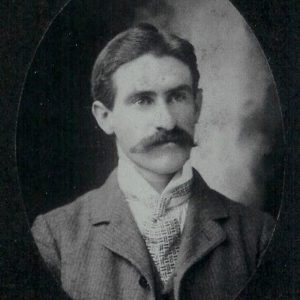
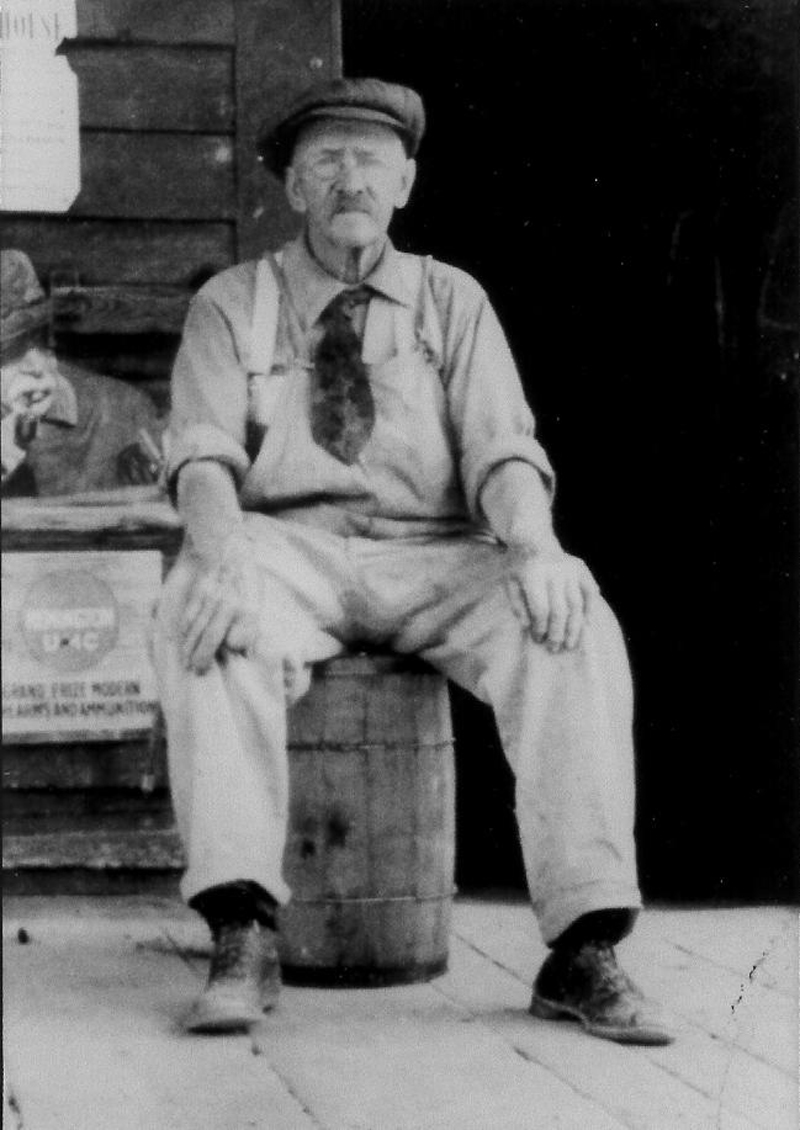
A number of key events took place at the Dorset Conventions, including the election of Seth Warner to the position of Lieutenant Colonel of the First Revolutionary Militia of the Green Mountain Boys, the creation of Vermont’s first Independent Congress, and a vote in which preeminent Vermonters passed a resolution to defend the cause of the still-forming United American States. In addition, the First Convention of the New Hampshire Grants was held there in 1776. As a result of the New Hampshire Grant Conventions, Vermont’s state government ultimately made the decision to become an independent state for the duration of the Revolutionary War.
In the years that followed, Vermont eventually joined the American Union, and the Kent family maintained significant land holdings in Dorset. Historians postulate that although William Williams had originally operated a tannery and harness shop further south of Dorset near Manchester, he made the decision to relocate his business to Dorset due to its proximity to his family’s estate. The tannery was constructed with large, mortised, hand-hewn timbers, and a subsequent addition was built onto the building in 1854. The combined structures were eventually crowned by a durable slate roof, and the tannery remained active until the dawn of the 20th century. Today, the building that once housed the tannery and harness shop now hosts a wonderful collection of outdoor apparel pieces, as well as a fanciful assortment of children’s toys and games. William Williams’ two sons, Charles and George, took the helm in the late 19th century after the conclusion of the Civil War, and the business was renamed, “William Williams & Sons.”
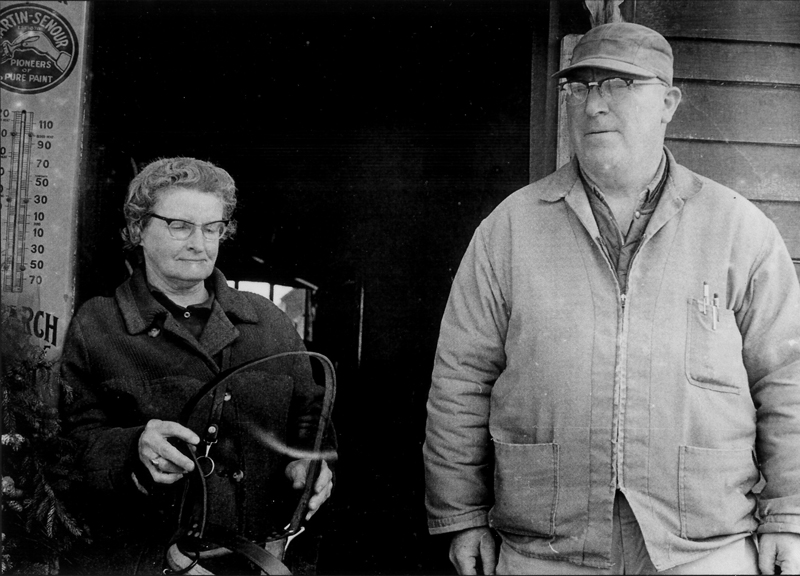
In 1893, George Williams’ son, Herbert Norton Williams took the reins, and eventually changed the name of the business to H.N. Williams. At the same time that Herbert was transitioning into a role of ownership, the tannery mill began to wind down its operations. Leather was subsequently sourced from other tanneries, and the harness shop continued to produce a variety of leather goods for the following several decades. Herbert significantly expanded the store’s inventory. In addition to selling the leather goods that were made on-site, H.N. Williams began to sell wagons, sleighs, bicycles, farm feed, and farm machinery. Although its focus has shifted, the store still sells farm feed and agricultural products to this day.
Herbert also oversaw several construction projects, including the addition of a grain storage building, which was located to the rear of the original structure. In 1905, a two-story white stable was moved from its former location on Church Street in Dorset to the H.N. Williams property. The stable was laid on a stone foundation just north of the main building. Over the next decade, the two buildings were connected. Directly east of the former stable, an addition was completed in the early 20th century. It now houses a room entirely dedicated to Carhartt® clothing.
The former stable building also hosts an expansive collection of women’s and children’s apparel, as well as a grocery outfitted with several refrigerators containing beverages, dairy products, and locally-sourced produce.
By 1937, H.N. Williams’ son, William (“Bill”) was at the helm. Bill was an active member of the local community who served as a deacon and trustee for the Dorset Church. He was also a member of the Dorset Players and a Treasurer of the Dorset Library. When Bill tragically passed away at an early age in 1947, his mother, Isabelle “Belle” Williams, stepped into a role of co-ownership, which she shared with Bill’s sister, Ada, and Ada’s husband, Austin Rumney. After holding the position of ownership for nearly forty years, Ada and Austin eventually passed the store onto their daughter, Ruth, and her husband, Dennis Brownlee, in 1985.
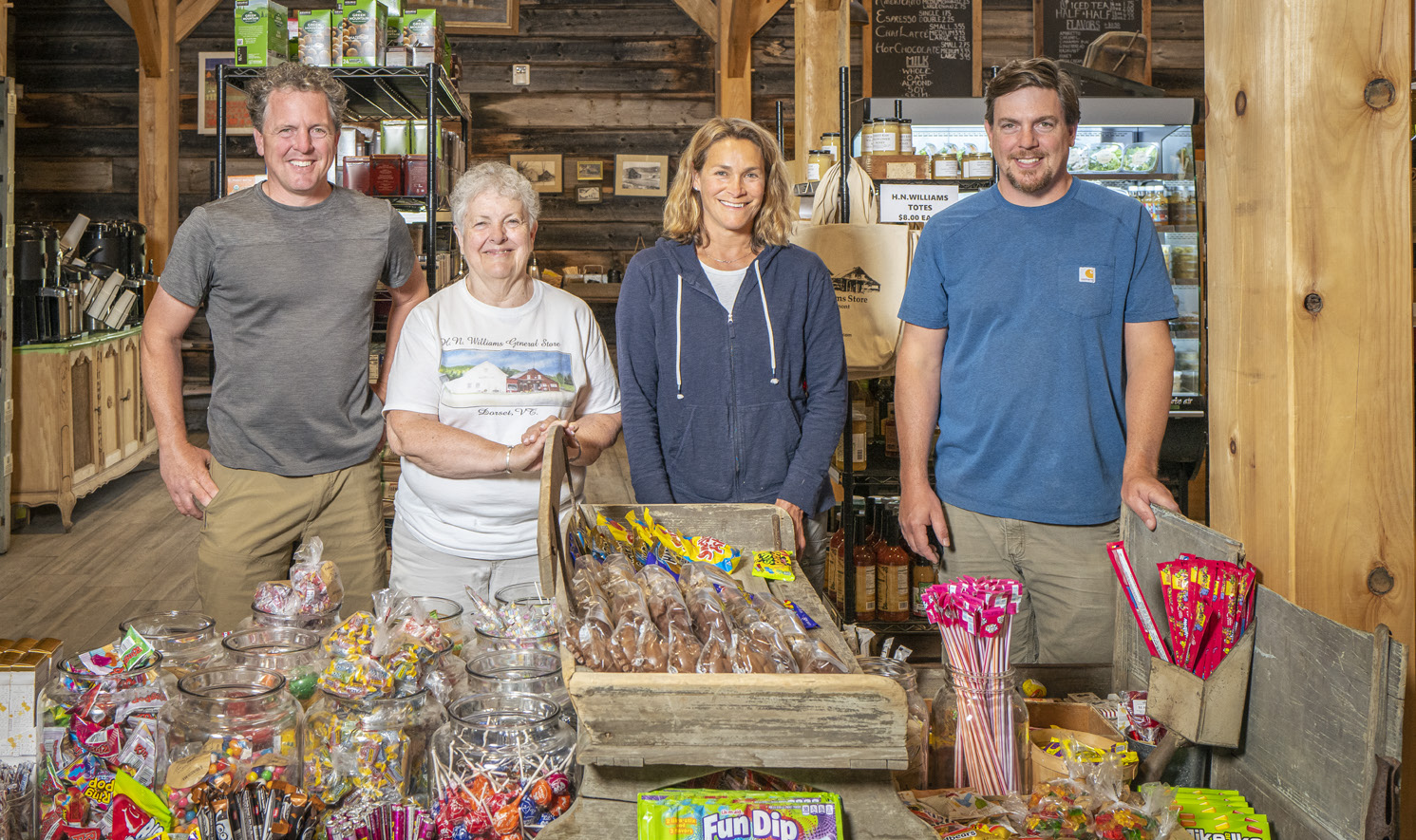
Thanks to Ruth and Dennis’ thoughtful stewardship, the store continued to maintain a strong foothold in the Southern Vermont business scene for decades. Ruth and Dennis went on to raise four children together, including the current owners, Gerritt and Billy Brownlee.
Building the Future
Before Billy Brownlee assumed the role of co-owner with his brother, Gerritt, he learned many valuable lessons during the years that he spent working in the store as a teenager. “My grandmother, Ada, ran the store for almost 40 years,” notes Brownlee. “She didn’t change much. She was pretty content with leaving things the way that they were. I remember writing out receipts by hand when I was working at the cash register and having to calculate the sales tax in my mind. Back in those days, everything was handwritten. I became very good at math by working in the store.”
After graduating from Burr & Burton Academy, Brownlee enrolled at the University of Vermont (UVM). Although his original intent was to major in Engineering, he switched his major to Business Management and Information Systems. “I started reflecting more on the family business, and I realized how I could apply what I was learning towards what we were doing here.”
Following his graduation from UVM, Brownlee alternated between working at the family store and working for Ignition, Inc., an Event Marketing company that was originally based in Manchester. In December of 2001, Brownlee began working at H.N. Williams on a full-time basis. Soon after, he oversaw the installation of a computerized point of sale system in 2002, which greatly improved the business’ efficiency. “Luckily, my parents and grandmother were open to the changes,” notes Brownlee. In the years that followed his full-time entry into the family business, Brownlee joined forces with his parents, Ruth and Dennis, and his brothers, Gerritt and Steven, to work on streamlining their inventory and merchandising systems. Over the next two decades, a number of additional changes were made, including the hiring of over a dozen new employees, a substantial expansion of their product ranges, and several bold construction and renovation projects.
The first of the major renovation projects began in 2007. “We put a whole new foundation underneath the building that was added onto the original structure in the early 1900s,” says Brownlee. “It was our first leap of faith, because we put a relatively significant amount of money into stabilizing the building and its foundations.” In addition, they decided to build a basement below the floor of the main building. Brownlee recalls: “We thought, ‘If we’re digging down this deep for the new foundation, why not just put in stairs and add another level?’ It added a lot of space to the store.” The finished basement now holds an extensive assortment of hardware goods, footwear, and work apparel. The top of the staircase is encircled by a steel railing that was crafted by the skilled metalworker, Sam Mosheim, and the basement features exposed beams and hemlock floors.
After the basement was completed in 2008, several walls in the original southern building were knocked down to better accommodate the flow of customer traffic, and the heating system was restructured.
Several years later, the Brownlee brothers purchased a barn that formerly housed their uncle’s workshop, which was located directly northeast of the original buildings. “Our uncle, Roger, built a successful business manufacturing hydrants that were used in the snowmaking industry,” says Brownlee. “After we bought the barn, we realized that we wanted to connect all of the buildings together. That’s when we started putting plans in motion for the ‘Post and Beam’ section of the building. We demolished his old barn and started building everything new again from the ground-up.”
Following years of careful planning, Billy Brownlee worked closely with respected architect and historian, Bill Badger, to draft the blueprints for a 3,200-square-foot addition. The addition would feature soaring ceilings, a coffee bar and “grab-and-go” deli station. There were numerous considerations that had to be addressed before construction could officially begin. “We had to have an engineer sign off on the snow load capacity for the roof, and we had to install a sprinkler system that was in line with safety codes. The large cistern that we built during the course of the renovation that took place in 2007 and 2008 helped us to accommodate those requirements. We had to install a massive fire pump, as well.” Working closely with a team of skilled local contractors to bring their vision into reality, construction began in the Spring of 2019.
In addition to overseeing the construction of the frame for the Post and Beam addition, Brownlee and his brothers, Gerritt and Steven, also put a considerable amount of time into working with the reclaimed wood that lines many of its walls. Brownlee elaborates: “Some of the walls are covered with weathered barnboard that we recovered from the outside of my uncle’s old workshop. We also used some wood from the inside of his workshop in between the bathrooms, and we covered the top of the northern- most interior wall with wood from old pallets. The three of us ripped old boards off of the barn, and we broke down pallets to get the pallet wood, as well. I also hand-stained and painted all of the wood behind the coffee counter. The reclaimed wood gives some really nice visual contrast to the addition.”
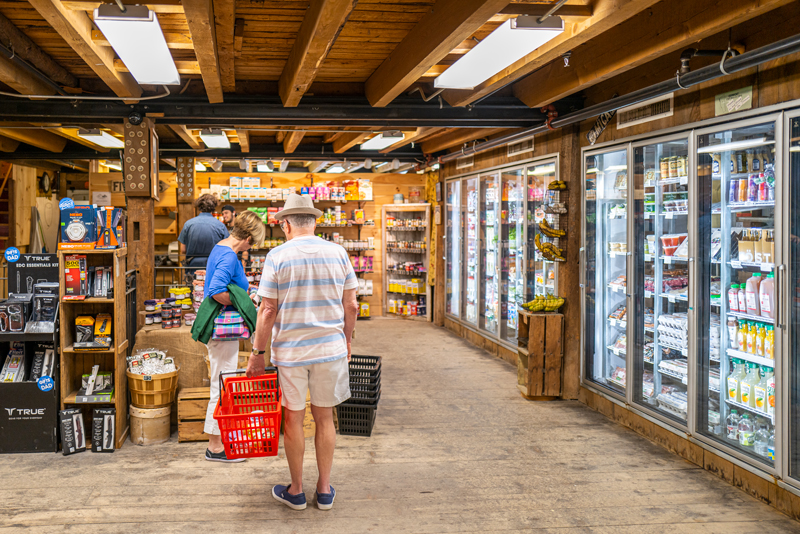
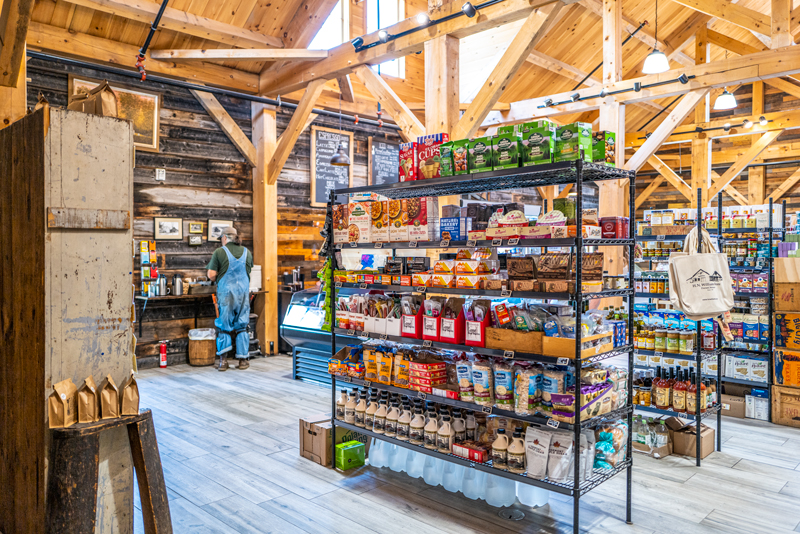
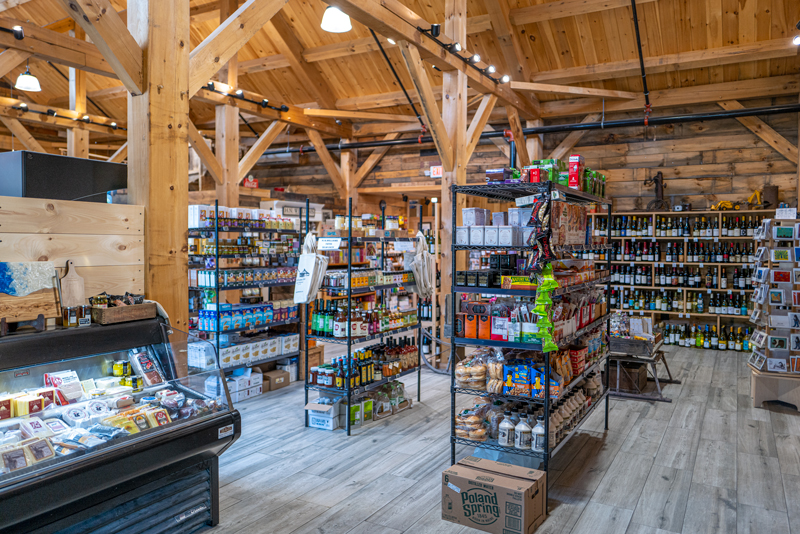
The Post and Beam section houses a phenomenal range of Vermont-made products, including items from Oak Summit Farm, Dorset Maple Reserve, Earth Sky Time, Rupert Rising Breads, Wilcox Ice Cream, Dorset Daughters, Lake Champlain Chocolates, Battenkill Brittle, and Small Batch Organics, among others. A row of refrigerators holds a broad assortment of small-batch Vermont craft beers from breweries such as Lawson’s Finest Liquids, Foley Brothers Brewing, Four Quarters Brewing, Zero Gravity, and many more. A full-service coffee bar on the western side of the room serves delicious espresso drinks and smoothies, and a “grab-and-go” deli section is stocked with scrumptious sandwiches, pasta dishes, appetizers, and freshly-made salads. “Our food volume went up significantly when we switched to the “grab-and-go” model and installed the display cooler. We’ve also integrated the online Toast® application into our deli program so that people can place custom food orders. It’s allowed us to bring our food program into the 21st century in an effective and customer-friendly way.” During the course of the construction campaign, a group of gas pumps were also installed outside of the northern entrance.
In order to connect the newest addition to the earlier buildings, the Brownlees had to come up with a way to solve another difficult engineering problem: “The barn building’s elevation was two feet higher than the original store,” notes Brownlee. “We decided to build a gently-sloping ramp that connects the Post and Beam section of the building to the original structures.”
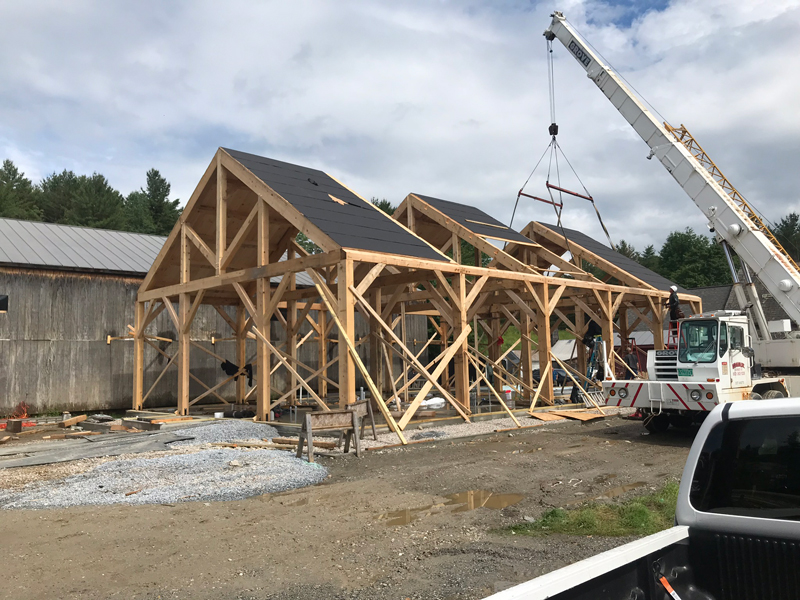
The Brownlees also decided to renovate the southern end of the structure in 2020. The beams there were raised three feet, and the back end of the store was thoroughly cleaned out and refurbished by Billy Brownlee and his wife, Blair. A new door and cash register were installed, as well.
As Brownlee looks towards the future, he is grateful to every loyal customer who continues to visit H.N. Williams, and he remains dedicated to the continual improvement of the family business. “When someone walks in the front door, we want to welcome them in every sense. That starts with having a welcoming staff, friendly owners, and an inviting environment and atmosphere. The layout and design of our spaces play a very central role in that, because the way that a store looks leaves a very important first impression. We’re proud to be part of the community here, and we want to serve the community in the best way possible. The way we see it, small acts of kindness can make a big impact. If there are a lot of people doing good things on a small scale, good things are going to keep happening as a direct result. We like to think that philosophy translates into how we run our business, and we want everyone who comes here to feel like they’re part of our extended family. We’ve come a long way since the store first opened its doors in 1840, and I think that we’re meeting the needs of our community better than ever before.”
ALL THE DETAILS
HNWILLIAMS.COM

